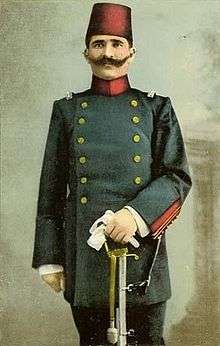Ahmed Niyazi Bey
| Ahmed Niyazi Bey | |
|---|---|
 | |
| Born |
1873 Resne, Ottoman Empire (present-day Republic of Macedonia) |
| Died |
1912 (aged 39) Durrës, Albania |
| Occupation | Bey and revolutionary |
Ahmed Niyazi Bey (1873–1912), (Turkish: Resneli Niyazi Bey, Ahmet Niyazi Bey; Albanian: Ahmet Njazi Bej Resnja; "Ahmet Niyazi Bey from Resen"), was the Ottoman bey of the Resne (now Resen, Republic of Macedonia) area in the late 19th and early 20th centuries.[1] An ethnic Albanian,[2][3][4] he was a member of the 1908 Young Turk Revolution. Ahmed Nyazi Bey is also known for the Saraj, a French-style estate he built in Resne.[5]
Niyazi Bey, a senior captain (Kolağası), raided the military depot in Resne and with two hundred men, including the town's mayor Hoca Cemal Efendi, escaped into the surrounding mountains from where he issued a proclamation calling for the restoration of the 1876 Constitution.[2] At roughly the same time, Major Ismail Enver Bey, a member of the Committee of Union and Progress (CUP), retreated into the mountains near Resne. Other officers followed both men's examples and took to the hills to form their own Çetes.[2] Because their actions carried the appearance of having sparked the Revolution, Niyazi and Enver, one Albanian and the other a Turk (Enver Bey's mother was Albanian[6]), later gained popular acclaim as the "heroes of freedom" (hürriyet kahramanları).[2] Of the two officers, Niyazi focused on mobilizing the Albanian community for the revolutionary cause.[2]
He was a Mücahit-i Muhterem (honoured fighter) and, in his dual capacity as hero of the constitutional revolution and revered member of the CUP, was a key figure throughout the whole Macedonian tour. He was killed by Sultan Abdul Hamid II's spies in 1912.
As a tribute to his role in the Young Turk Revolution that began the Second Constitutional Era of the Ottoman Empire, his name is mentioned along with Enver's in the March of the Deputies (Turkish: Mebusan Marşı or Meclis-i Mebusan Marşı), the anthem of the Chamber of Deputies, the lower house of the Ottoman parliament. It was performed in 1909 upon the opening of the parliament. The fourth line of the anthem reads "Long live Niyazi, long live Enver" (Turkish: "Yaşasın Niyazi, yaşasın Enver").
See also
- Enver Pasha, his fellow revolutionary
- Saraj (Resen), his residence
References
| Wikimedia Commons has media related to Ahmed Niyazi Bey. |
- ↑ "Фотографот Цуле отиде по трагите на грофицата Рене". ПРИКАЗНА ЗА САРАЈОТ И ЉУБОВТА НА ДУЉАНОВИ ОД РЕСЕН. Вечер. Archived from the original on 16 October 2012. Retrieved 5 September 2011.
- 1 2 3 4 5 Walter Gawrych, George (2006). The Crescent and the Eagle: Ottoman Rule, Islam and the Albanians, 1874-1913. I.B.Tauris. p. 150. ISBN 1-84511-287-3. Retrieved 23 April 2012.
- ↑ Kedourie, Sylvia (2000). Seventy-five years of the Turkish Republic. Psychology Press. p. 32. ISBN 978-0-7146-5042-5. Retrieved 18 February 2011.
- ↑ Hanioglu, M. Sükrü (2011). Atatürk: An Intellectual Biography. Princeton University Press. p. 69. ISBN 978-0-691-15109-0. Retrieved 23 April 2012.
- ↑ Macedonia National Tourism Portal Archived 15 November 2006 at the Wayback Machine.
- ↑ Mazaower, Mark "Salonica, City of Ghosts: Christians, Muslims and Jews 1430-1950."